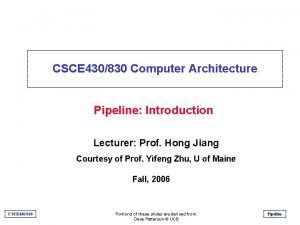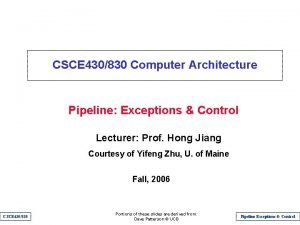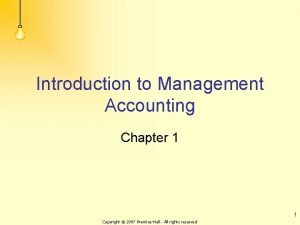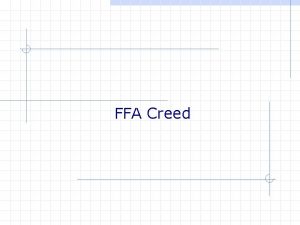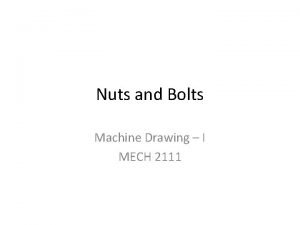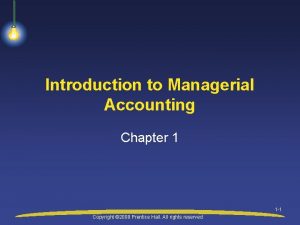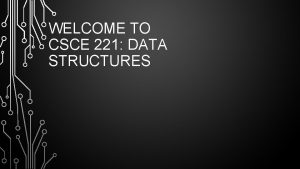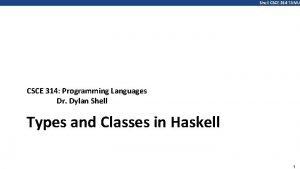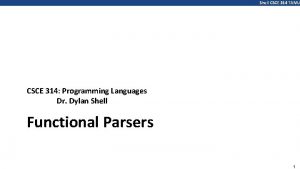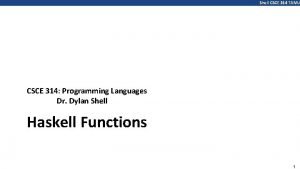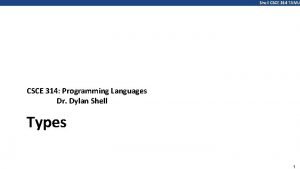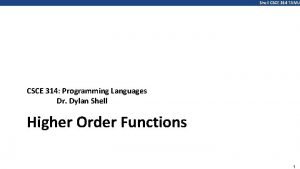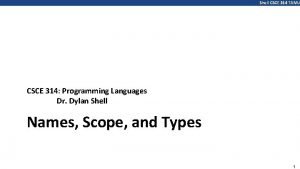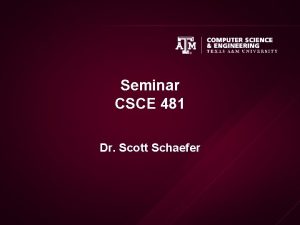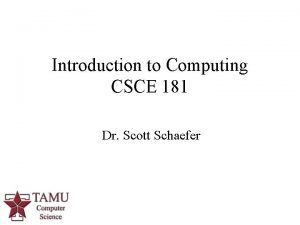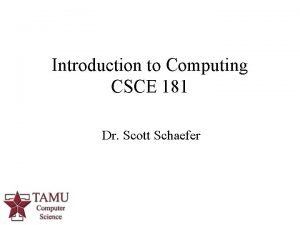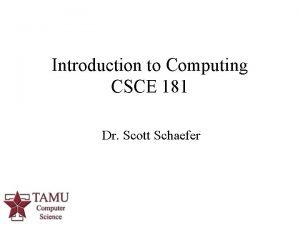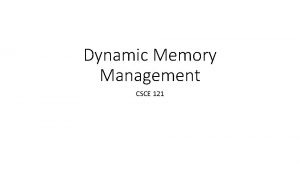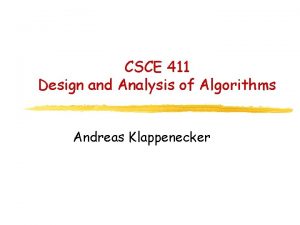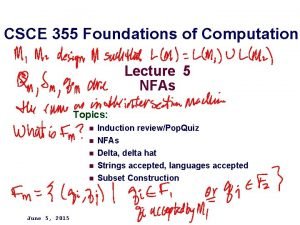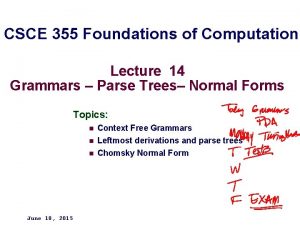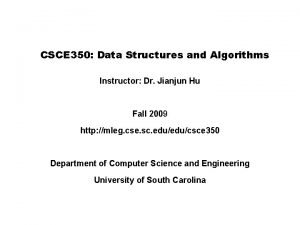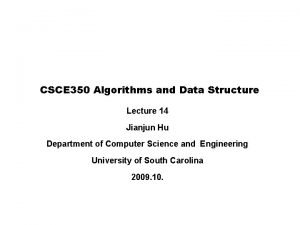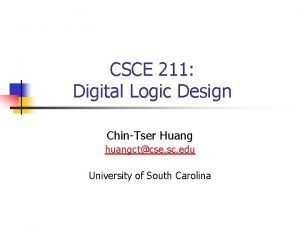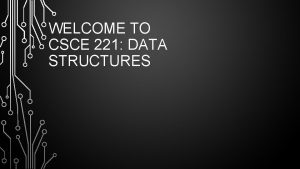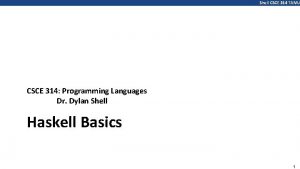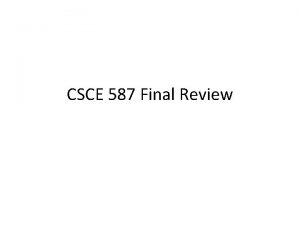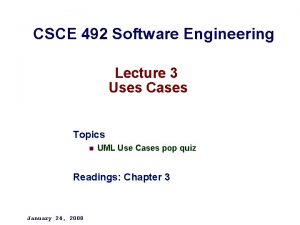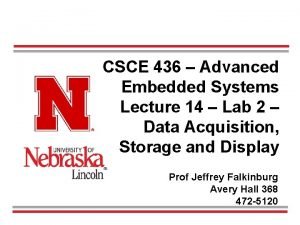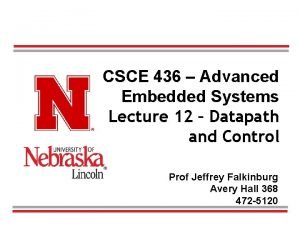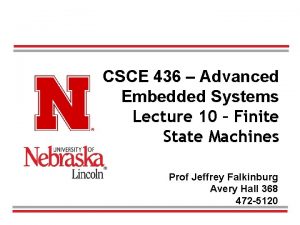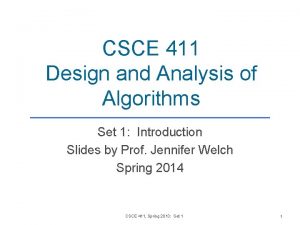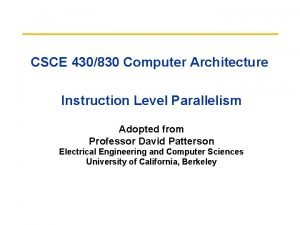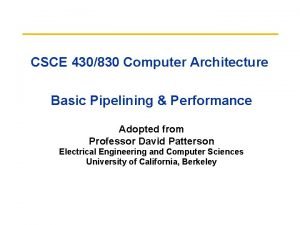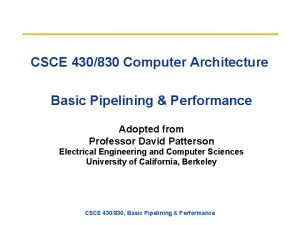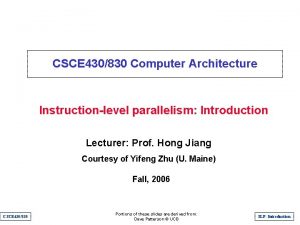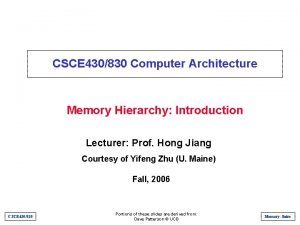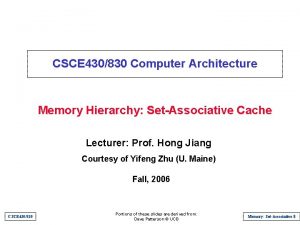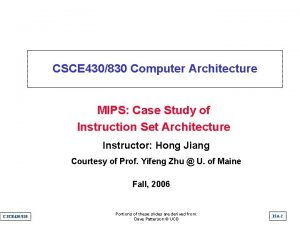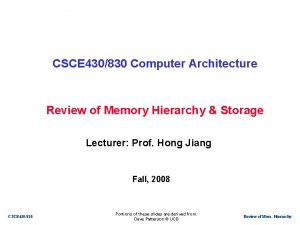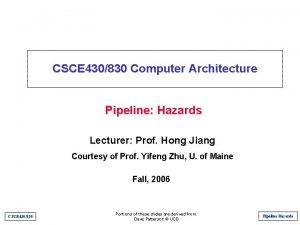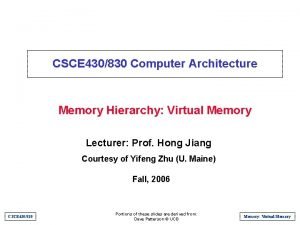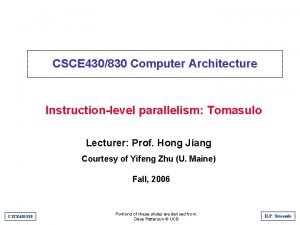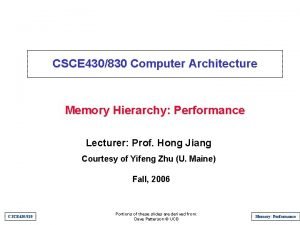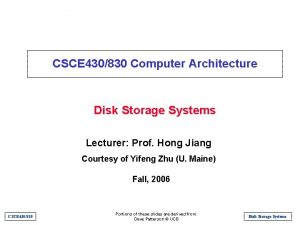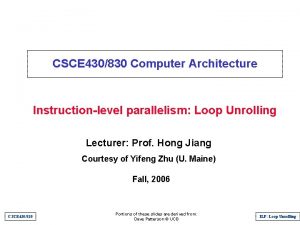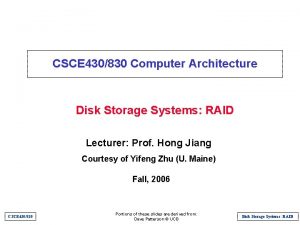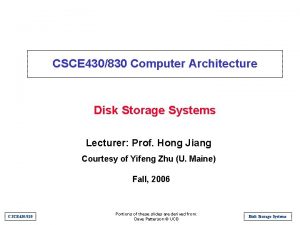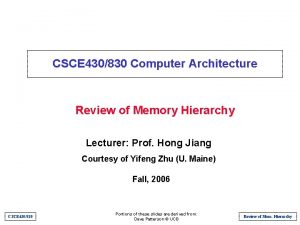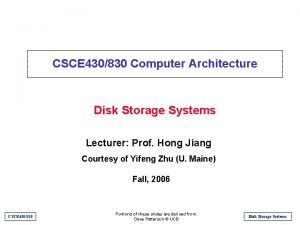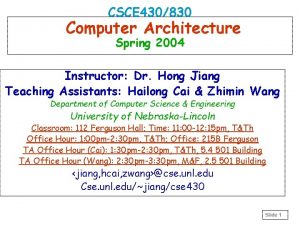CSCE 430830 Computer Architecture Introduction Adopted from Professor










![Instruction Set Architecture “. . . the attributes of a [computing] system as seen Instruction Set Architecture “. . . the attributes of a [computing] system as seen](https://slidetodoc.com/presentation_image_h/9c42ca14be754c4747280e054386492a/image-11.jpg)





































- Slides: 48

CSCE 430/830 Computer Architecture Introduction Adopted from Professor David Patterson Electrical Engineering and Computer Sciences University of California, Berkeley

Outline • Computer Science at a Crossroads • Computer Architecture v. Instruction Set Arch. • What Computer Architecture brings to table 11/25/2020 CSCE 430/830, Fundamentals of Computer Design 2

Crossroads: Conventional Wisdom in Comp. Arch • Old Conventional Wisdom: Power is free, Transistors expensive • New Conventional Wisdom: “Power wall” Power expensive, Xtors free (Can put more on chip than can afford to turn on) • Old CW: Sufficiently increasing Instruction Level Parallelism via compilers, innovation (Out-of-order, speculation, VLIW, …) • New CW: “ILP wall” law of diminishing returns on more HW for ILP • Old CW: Multiplies are slow, Memory access is fast • New CW: “Memory wall” Memory slow, multiplies fast (200 clock cycles to DRAM memory, 4 clocks for multiply) • Old CW: Uniprocessor performance 2 X / 1. 5 yrs • New CW: Power Wall + ILP Wall + Memory Wall = Brick Wall – Uniprocessor performance now 2 X / 5(? ) yrs Sea change in chip design: multiple “cores” (2 X processors per chip / ~ 2 years) » More simpler processors are more power efficient 11/25/2020 CSCE 430/830, Fundamentals of Computer Design 3

Crossroads: Uniprocessor Performance From Hennessy and Patterson, Computer Architecture: A Quantitative Approach, 4 th edition, October, 2006 • VAX : 25%/year 1978 to 1986 • RISC + x 86: 52%/year 1986 to 2002 • RISC + x 86: ? ? %/year 2002 to present 11/25/2020 CSCE 430/830, Fundamentals of Computer Design 4

Sea Change in Chip Design • Intel 4004 (1971): 4 -bit processor, 2312 transistors, 0. 4 MHz, 10 micron PMOS, 11 mm 2 chip • RISC II (1983): 32 -bit, 5 stage pipeline, 40, 760 transistors, 3 MHz, 3 micron NMOS, 60 mm 2 chip • 125 mm 2 chip, 0. 065 micron CMOS = 2312 RISC II+FPU+Icache+Dcache – RISC II shrinks to ~ 0. 02 mm 2 at 65 nm – Caches via DRAM or 1 transistor SRAM (www. t-ram. com) ? – Proximity Communication via capacitive coupling at > 1 TB/s ? (Ivan Sutherland @ Sun / Berkeley) • Processor is the new transistor? 11/25/2020 CSCE 430/830, Fundamentals of Computer Design 5

Déjà vu all over again? • Multiprocessors imminent in 1970 s, ‘ 80 s, ‘ 90 s, … • “… today’s processors … are nearing an impasse as technologies approach the speed of light. . ” David Mitchell, The Transputer: The Time Is Now (1989) • Transputer was premature Custom multiprocessors strove to lead uniprocessors Procrastination rewarded: 2 X seq. perf. / 1. 5 years • “We are dedicating all of our future product development to multicore designs. … This is a sea change in computing” Paul Otellini, President, Intel (2004) • Difference is all microprocessor companies switch to multiprocessors (AMD, Intel, IBM, Sun; all new Apples 2 CPUs) Procrastination penalized: 2 X sequential perf. / 5 yrs Biggest programming challenge: 1 to 2 CPUs 11/25/2020 CSCE 430/830, Fundamentals of Computer Design 6

Problems with Sea Change • Algorithms, Programming Languages, Compilers, Operating Systems, Architectures, Libraries, … not ready to supply Thread Level Parallelism or Data Level Parallelism for 1000 CPUs / chip, Architectures not ready for 1000 CPUs / chip • • • Unlike Instruction Level Parallelism, cannot be solved by just computer architects and compiler writers alone, but also cannot be solved without participation of computer architects This edition of (4 th Edition) textbook, Computer Architecture: A Quantitative Approach, explores shift from Instruction Level Parallelism to Thread Level Parallelism / Data Level Parallelism 11/25/2020 CSCE 430/830, Fundamentals of Computer Design 7

Outline • Computer Science at a Crossroads • Computer Architecture v. Instruction Set Arch. • What Computer Architecture brings to table 11/25/2020 CSCE 430/830, Fundamentals of Computer Design 8

Instruction Set Architecture: Critical Interface software instruction set hardware • Properties of a good abstraction – – Lasts through many generations (portability) Used in many different ways (generality) Provides convenient functionality to higher levels Permits an efficient implementation at lower levels 11/25/2020 CSCE 430/830, Fundamentals of Computer Design 9

Example: MIPS r 0 r 1 ° ° ° r 31 PC lo hi 0 Programmable storage Data types ? 2^32 x bytes Format ? 31 x 32 -bit GPRs (R 0=0) Addressing Modes? 32 x 32 -bit FP regs (paired DP) Operations? HI, LO, PC Arithmetic logical Add, Add. U, Sub. U, And, Or, Xor, Nor, SLTU, Add. IU, SLTIU, And. I, Or. I, Xor. I, LUI SLL, SRA, SLLV, SRAV Memory Access LB, LBU, LHU, LWL, LWR SB, SH, SWL, SWR Control 32 -bit instructions on word boundary J, JAL, JR, JALR BEq, BNE, BLEZ, BGTZ, BLTZ, BGEZ, BLTZAL, BGEZAL 11/25/2020 CSCE 430/830, Fundamentals of Computer Design 10
![Instruction Set Architecture the attributes of a computing system as seen Instruction Set Architecture “. . . the attributes of a [computing] system as seen](https://slidetodoc.com/presentation_image_h/9c42ca14be754c4747280e054386492a/image-11.jpg)
Instruction Set Architecture “. . . the attributes of a [computing] system as seen by the programmer, i. e. the conceptual structure and functional behavior, as distinct from the organization of the data flows and controls, the logic design, and the physical implementation. ” – Amdahl, Blaauw, and Brooks, 1964 SOFTWARE -- Organization of Programmable Storage -- Data Types & Data Structures: Encodings & Representations -- Instruction Formats -- Instruction (or Operation Code) Set -- Modes of Addressing and Accessing Data Items and Instructions -- Exceptional Conditions 11/25/2020 CSCE 430/830, Fundamentals of Computer Design 11

ISA vs. Computer Architecture • Old definition of computer architecture = instruction set design – Other aspects of computer design called implementation – Insinuates implementation is uninteresting or less challenging • Our view is computer architecture >> ISA • Architect’s job much more than instruction set design; technical hurdles today more challenging than those in instruction set design • Since instruction set design not where action is, some conclude computer architecture (using old definition) is not where action is – We disagree on conclusion – Agree that ISA not where action is (ISA in CA: AQA 4/e appendix) 11/25/2020 CSCE 430/830, Fundamentals of Computer Design 12

Comp. Arch. is an Integrated Approach • What really matters is the functioning of the complete system – hardware, runtime system, compiler, operating system, and application – In networking, this is called the “End to End argument” • Computer architecture is not just about transistors, individual instructions, or particular implementations – E. g. , Original RISC projects replaced complex instructions with a compiler + simple instructions 11/25/2020 CSCE 430/830, Fundamentals of Computer Design 13

Computer Architecture is Design and Analysis Architecture is an iterative process: • Searching the space of possible designs • At all levels of computer systems Creativity Cost / Performance Analysis Good Ideas 11/25/2020 Bad Ideas Mediocre Ideas CSCE 430/830, Fundamentals of Computer Design 14

CSCE 430/830 Course Focus Understanding the design techniques, machine structures, technology factors, evaluation methods that will determine the form of computers in 21 st Century Technology Applications Programming Languages Computer Architecture: • Organization • Hardware/Software Boundary Operating Systems 11/25/2020 Parallelism Measurement & Evaluation CSCE 430/830, Fundamentals of Computer Design Interface Design (ISA) Compilers History 15

Outline • • Computer Science at a Crossroads Computer Architecture v. Instruction Set Arch. What Computer Architecture brings to table Technology Trends 11/25/2020 CSCE 430/830, Fundamentals of Computer Design 16

What Computer Architecture brings to Table • • Other fields often borrow ideas from architecture Quantitative Principles of Design 1. 2. 3. 4. 5. • Careful, quantitative comparisons – – • • Take Advantage of Parallelism Principle of Locality Focus on the Common Case Amdahl’s Law The Processor Performance Equation Define, quantity, and summarize relative performance Define and quantify relative cost Define and quantify dependability Define and quantify power Culture of anticipating and exploiting advances in technology Culture of well-defined interfaces that are carefully implemented and thoroughly checked 11/25/2020 CSCE 430/830, Fundamentals of Computer Design 17

1) Taking Advantage of Parallelism • Increasing throughput of server computer via multiple processors or multiple disks • Detailed HW design – Carry lookahead adders (Ci+1 = Gi + Pi. Ci) uses parallelism to speed up computing sums from linear to logarithmic in number of bits per operand – Multiple memory banks searched in parallel in set-associative caches • Pipelining: overlap instruction execution to reduce the total time to complete an instruction sequence. – Not every instruction depends on immediate predecessor executing instructions completely/partially in parallel possible – Classic 5 -stage pipeline: 1) Instruction Fetch (Ifetch), 2) Register Read (Reg), 3) Execute (ALU), 4) Data Memory Access (Dmem), 5) Register Write (Reg) 11/25/2020 CSCE 430/830, Fundamentals of Computer Design 18

Pipelined Instruction Execution Time (clock cycles) 11/25/2020 Ifetch DMem Reg ALU O r d e r Ifetch ALU I n s t r. ALU Cycle 1 Cycle 2 Cycle 3 Cycle 4 Cycle 5 Cycle 6 Cycle 7 Ifetch Reg CSCE 430/830, Fundamentals of Computer Design Reg DMem Reg 19

Limits to pipelining • Hazards prevent next instruction from executing during its designated clock cycle 11/25/2020 Reg DMem Ifetch Reg ALU O r d e r Ifetch ALU I n s t r. ALU – Structural hazards: attempt to use the same hardware to do two different things at once – Data hazards: Instruction depends on result of prior instruction still in the pipeline – Control hazards: Caused by delay between the fetching of instructions and decisions about changes in control flow (branches and jumps). Time (clock cycles) Reg CSCE 430/830, Fundamentals of Computer Design Reg DMem Reg 20

2) The Principle of Locality • The Principle of Locality: – Program access a relatively small portion of the address space at any instant of time. • Two Different Types of Locality: – Temporal Locality (Locality in Time): If an item is referenced, it will tend to be referenced again soon (e. g. , loops, reuse) – Spatial Locality (Locality in Space): If an item is referenced, items whose addresses are close by tend to be referenced soon (e. g. , straight-line code, array access) • Last 30 years, HW relied on locality for memory perf. P 11/25/2020 $ MEM CSCE 430/830, Fundamentals of Computer Design 21

Levels of the Memory Hierarchy Capacity Access Time Cost Staging Xfer Unit CPU Registers 100 s Bytes 300 – 500 ps (0. 3 -0. 5 ns) L 1 and L 2 Cache 10 s-100 s K Bytes ~1 ns - ~10 ns $1000 s/ GByte Main Memory G Bytes 80 ns- 200 ns ~ $100/ GByte Disk 10 s T Bytes, 10 ms (10, 000 ns) ~ $1 / GByte Tape infinite sec-min ~$1 / GByte 11/25/2020 Registers Instr. Operands L 1 Cache Blocks Upper Level prog. /compiler 1 -8 bytes faster cache cntl 32 -64 bytes L 2 Cache Blocks cache cntl 64 -128 bytes Memory Pages OS 4 K-8 K bytes Files user/operator Mbytes Disk Tape CSCE 430/830, Fundamentals of Computer Design Larger Lower Level 22

3) Focus on the Common Case • Common sense guides computer design – Since its engineering, common sense is valuable • In making a design trade-off, favor the frequent case over the infrequent case – E. g. , Instruction fetch and decode unit used more frequently than multiplier, so optimize it 1 st – E. g. , If database server has 50 disks / processor, storage dependability dominates system dependability, so optimize it 1 st • Frequent case is often simpler and can be done faster than the infrequent case – E. g. , overflow is rare when adding 2 numbers, so improve performance by optimizing more common case of no overflow – May slow down overflow, but overall performance improved by optimizing for the normal case • What is frequent case and how much performance improved by making case faster => Amdahl’s Law 11/25/2020 CSCE 430/830, Fundamentals of Computer Design 23

Focus on the Common Case • CPU replaced by a new CPU 10 X faster • I/O bound server, so 60% time waiting for I/O • How much of the system performance is improved by the new CPU? 11/25/2020 CSCE 430/830, Fundamentals of Computer Design 24

4) Amdahl’s Law Best you could ever hope to do: 11/25/2020 CSCE 430/830, Fundamentals of Computer Design 25

Amdahl’s Law example • New CPU 10 X faster • I/O bound server, so 60% time waiting for I/O • Apparently, its human nature to be attracted by 10 X faster, vs. keeping in perspective its just 1. 6 X faster 11/25/2020 CSCE 430/830, Fundamentals of Computer Design 26

CPI 5) Processor performance equation inst count CPU time = Seconds = Instructions x Program CPI Program Compiler X (X) Inst. Set. X X Technology 11/25/2020 x Seconds Instruction Inst Count X Organization Cycles X Cycle time Cycle Clock Rate X X CSCE 430/830, Fundamentals of Computer Design 27

What’s a Clock Cycle? Latch or register combinational logic • Old days: 10 levels of gates • Today: determined by numerous time-of-flight issues + gate delays – clock propagation, wire lengths, drivers 11/25/2020 CSCE 430/830, Fundamentals of Computer Design 28

And in conclusion … • Computer Architecture >> instruction sets • Computer Architecture skill sets are different – – 5 Quantitative principles of design Quantitative approach to design Solid interfaces that really work Technology tracking and anticipation • Computer Science at the crossroads from sequential to parallel computing – Salvation requires innovation in many fields, including computer architecture • Read Chapter 1, then Appendix A, record bugs! 11/25/2020 CSCE 430/830, Fundamentals of Computer Design 29

In-class exercise 1. If the CPU of a computer system is used 60% of the time and is considered for an upgrade. In order to double the performance of this computer system, how much faster the CPU must be than the old one? 2. What if the CPU is used 50% of the time? 11/25/2020 CSCE 430/830, Fundamentals of Computer Design 30

Outline • • Review Technology Trends: Culture of tracking, anticipating and exploiting advances in technology • Careful, quantitative comparisons: 1. Define and quantity power 2. Define and quantity dependability 3. Define, quantity, and summarize relative performance 11/25/2020 CSCE 430/830, Fundamentals of Computer Design 48

Define and quantify power ( 1 / 2) • For CMOS chips, traditional dominant energy consumption has been in switching transistors, called dynamic power • For mobile devices, energy is a better metric • For a fixed task, slowing clock rate (frequency switched) reduces power, but not energy • Capacitive load a function of number of transistors connected to output and technology, which determines capacitance of wires and transistors • Dropping voltage helps both, so went from 5 V to 1 V • To save energy & dynamic power, most CPUs now turn off clock of inactive modules (e. g. Fl. Pt. Unit) 11/25/2020 CSCE 430/830, Fundamentals of Computer Design 49

Example of quantifying power • Suppose 15% reduction in voltage results in a 15% reduction in frequency. What is impact on dynamic power? 11/25/2020 CSCE 430/830, Fundamentals of Computer Design 50

Define and quantify power (2 / 2) • Because leakage current flows even when a transistor is off, now static power important too • Leakage current increases in processors with smaller transistor sizes • Increasing the number of transistors increases power even if they are turned off • In 2006, goal for leakage is 25% of total power consumption; high performance designs at 40% • Very low power systems even gate voltage to inactive modules to control loss due to leakage 11/25/2020 CSCE 430/830, Fundamentals of Computer Design 51

Outline • • Review Technology Trends: Culture of tracking, anticipating and exploiting advances in technology • Careful, quantitative comparisons: 1. Define and quantity power 2. Define and quantity dependability 3. Define, quantity, and summarize relative performance 11/25/2020 CSCE 430/830, Fundamentals of Computer Design 52

Define and quantify dependability (1/3) • • How decide when a system is operating properly? Infrastructure providers now offer Service Level Agreements (SLA) to guarantee that their networking or power service would be dependable • Systems alternate between 2 states of service with respect to an SLA: 1. Service accomplishment, where the service is delivered as specified in SLA 2. Service interruption, where the delivered service is different from the SLA • Failure = transition from state 1 to state 2 • Restoration = transition from state 2 to state 1 11/25/2020 CSCE 430/830, Fundamentals of Computer Design 53

Define and quantify dependability (2/3) • Module reliability = measure of continuous service accomplishment (or time to failure). 2 metrics 1. Mean Time To Failure (MTTF) measures Reliability 2. Failures In Time (FIT) = 1/MTTF, the rate of failures • • Traditionally reported as failures per billion hours of operation Mean Time To Repair (MTTR) measures Service Interruption – Mean Time Between Failures (MTBF) = MTTF+MTTR • • Module availability measures service as alternate between the 2 states of accomplishment and interruption (number between 0 and 1, e. g. 0. 9) Module availability = MTTF / ( MTTF + MTTR) 11/25/2020 CSCE 430/830, Fundamentals of Computer Design 54

Example calculating reliability • • If modules have exponentially distributed lifetimes (age of module does not affect probability of failure), overall failure rate is the sum of failure rates of the modules Calculate FIT and MTTF for 10 disks (1 M hour MTTF per disk), 1 disk controller (0. 5 M hour MTTF), and 1 power supply (0. 2 M hour MTTF): 11/25/2020 CSCE 430/830, Fundamentals of Computer Design 55

Example calculating reliability • • If modules have exponentially distributed lifetimes (age of module does not affect probability of failure), overall failure rate is the sum of failure rates of the modules Calculate FIT and MTTF for 10 disks (1 M hour MTTF per disk), 1 disk controller (0. 5 M hour MTTF), and 1 power supply (0. 2 M hour MTTF): 11/25/2020 CSCE 430/830, Fundamentals of Computer Design 56

Outline • • Review Technology Trends: Culture of tracking, anticipating and exploiting advances in technology • Careful, quantitative comparisons: 1. Define and quantity power 2. Define and quantity dependability 3. Define, quantity, and summarize relative performance 11/25/2020 CSCE 430/830, Fundamentals of Computer Design 57

Definition: Performance • Performance is in units of things per sec – bigger is better • If we are primarily concerned with response time performance(x) = 1 execution_time(x) " X is n times faster than Y" means Performance(X) n = = Performance(Y) 11/25/2020 Execution_time(Y) Execution_time(X) CSCE 430/830, Fundamentals of Computer Design 58

Performance: What to measure • Usually rely on benchmarks vs. real workloads • To increase predictability, collections of benchmark applications, called benchmark suites, are popular • SPECCPU: popular desktop benchmark suite – – CPU only, split between integer and floating point programs SPECint 2000 has 12 integer, SPECfp 2000 has 14 integer pgms SPECCPU 2006 announced Spring 2006 SPECSFS (NFS file server) and SPECWeb (Web. Server) added as server benchmarks • Transaction Processing Council measures server performance and cost-performance for databases – – TPC-C Complex query for Online Transaction Processing TPC-H models ad hoc decision support TPC-W a transactional web benchmark TPC-App application server and web services benchmark 11/25/2020 CSCE 430/830, Fundamentals of Computer Design 59

How Summarize Suite Performance (1/5) • Arithmetic average of execution time of all pgms? – But they vary by 4 X in speed, so some would be more important than others in arithmetic average • Could add a weights per program, but how pick weight? – Different companies want different weights for their products • SPECRatio: Normalize execution times to reference computer, yielding a ratio proportional to performance = time on reference computer time on computer being rated 11/25/2020 CSCE 430/830, Fundamentals of Computer Design 60

How Summarize Suite Performance (2/5) • If program SPECRatio on Computer A is 1. 25 times bigger than Computer B, then • Note that when comparing 2 computers as a ratio, execution times on the reference computer drop out, so choice of reference computer is irrelevant 11/25/2020 CSCE 430/830, Fundamentals of Computer Design 61

How Summarize Suite Performance (3/5) • Since ratios, proper mean is geometric mean (SPECRatio unitless, so arithmetic meaningless) 1. Geometric mean of the ratios is the same as the ratio of the geometric means 2. Ratio of geometric means = Geometric mean of performance ratios choice of reference computer is irrelevant! • These two points make geometric mean of ratios attractive to summarize performance 11/25/2020 CSCE 430/830, Fundamentals of Computer Design 62

How Summarize Suite Performance (4/5) • Does a single mean well summarize performance of programs in benchmark suite? • Can decide if mean a good predictor by characterizing variability of distribution using standard deviation • Like geometric mean, geometric standard deviation is multiplicative rather than arithmetic • Can simply take the logarithm of SPECRatios, compute the standard mean and standard deviation, and then take the exponent to convert back: 11/25/2020 CSCE 430/830, Fundamentals of Computer Design 63

How Summarize Suite Performance (5/5) • Standard deviation is more informative if know distribution has a standard form – bell-shaped normal distribution, whose data are symmetric around mean – lognormal distribution, where logarithms of data--not data itself--are normally distributed (symmetric) on a logarithmic scale • For a lognormal distribution, we expect that 68% of samples fall in range 95% of samples fall in range • Note: Excel provides functions EXP(), LN(), and STDEV() that make calculating geometric mean and multiplicative standard deviation easy 11/25/2020 CSCE 430/830, Fundamentals of Computer Design 64

And in conclusion … • Tracking and extrapolating technology part of architect’s responsibility • Expect Bandwidth in disks, DRAM, network, and processors to improve by at least as much as the square of the improvement in Latency • Quantify dynamic and static power – Capacitance x Voltage 2 x frequency, Energy vs. power • Quantify dependability – Reliability (MTTF, FIT), Availability (99. 9…) • Quantify and summarize performance – Ratios, Geometric Mean, Multiplicative Standard Deviation • Read Appendix A, record bugs online! 11/25/2020 CSCE 430/830, Fundamentals of Computer Design 68
 Csce 430
Csce 430 430830
430830 Architecture
Architecture Promotion from associate professor to professor
Promotion from associate professor to professor Three bus architecture
Three bus architecture Computer architecture and organization difference
Computer architecture and organization difference Flow chart for interrupt cycle
Flow chart for interrupt cycle Introduction to computer organization and architecture
Introduction to computer organization and architecture Unit cost meaning
Unit cost meaning Author of the ffa creed
Author of the ffa creed Republic act no. 55 manuel roxas
Republic act no. 55 manuel roxas Job cost meaning
Job cost meaning Public law 740 passed by congress
Public law 740 passed by congress Ffa colors and meaning
Ffa colors and meaning The drug basket method is used to dispense medication
The drug basket method is used to dispense medication Who are responsible for curriculum development in pakistan
Who are responsible for curriculum development in pakistan Who wrote the ffa creed?
Who wrote the ffa creed? The institute of management accountants adopted the ______.
The institute of management accountants adopted the ______. Third paragraph of the ffa creed
Third paragraph of the ffa creed The method of unit costing is adopted by
The method of unit costing is adopted by Conventional representation of internal thread
Conventional representation of internal thread When was the ffa creed adopted and amended
When was the ffa creed adopted and amended The institute of management accountants adopted the ______.
The institute of management accountants adopted the ______. Csce 221 tamu syllabus
Csce 221 tamu syllabus Csce 314
Csce 314 Csce 314
Csce 314 Csce 314
Csce 314 Csce 314 tamu
Csce 314 tamu Csce 314
Csce 314 Csce 314
Csce 314 Scott schaefer tamu
Scott schaefer tamu Csce 181
Csce 181 Csce 181
Csce 181 Csce courses tamu
Csce courses tamu Csce 121 tamu
Csce 121 tamu Csce 411
Csce 411 Csce 355
Csce 355 Csce 355
Csce 355 Csce 350
Csce 350 Csce 350
Csce 350 Csce 211
Csce 211 Tamu csce 221
Tamu csce 221 Csce 313 github
Csce 313 github Csce 587
Csce 587 Csce 492
Csce 492 Csce 436
Csce 436 Csce 436
Csce 436 Csce 436
Csce 436 Csce 411 tamu
Csce 411 tamu
